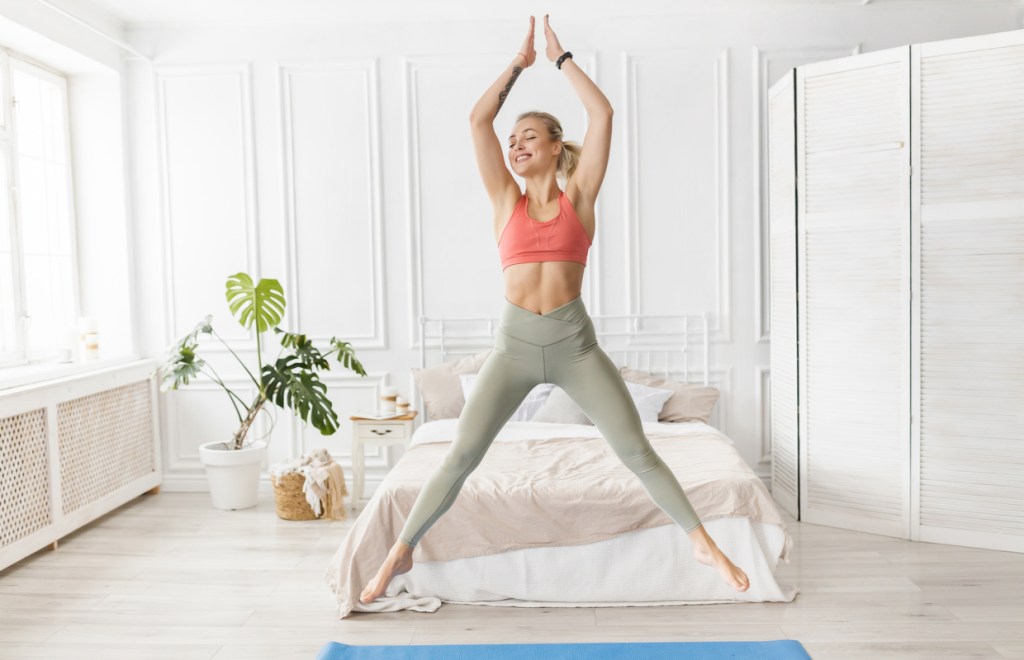How to live your best life
We caught up with the experts to discover the key ingredients required to create the life of your dreams...

At the start of a new year, many of us find ourselves gathering a pristine notebook and a rainbow of felt-tipped pens, ready to note down our goals and resolutions – it’s a common approach by many when trying to figure out how to live your best life. But a few months on, when we revisit those pages only to find that we haven’t made as much progress as we intended, it’s easy to feel a bit despondent. Where exactly are we going wrong?
According to the wellness experts, many of us are stumbling at the first hurdle when trying to create the life of our dreams. We focus so much on the final destination, where we believe we will finally be happy, that we overlook our smaller accomplishments and miss out on the simple joys of day-to-day life.
As poet David Whyte writes, in his book Consolations (Canongate, £14.99): ‘It is always hard to believe that the courageous step is so close to us, that it is closer than we ever could imagine, that in fact, we already know what it is, and that the step is simpler, more radical than we had thought: which is why we so often prefer the story to be more elaborate, our identities clouded by fear, the horizon safely in the distance, the essay longer than it needs to be and the answer safely in the realm of impossibility.’
Are you in danger of making the vision for your future too grandiose, overcomplicating things that could in fact be simple? We catch up with the experts to find out and, in so doing, discover how to live your best live in five basic steps…
How to live your best life

1. Structure your goals
When trying to figure out how to live your best life, you might make the mistake of setting big, shiny goals without fully understanding the way to achieve them. There is a trope among self-development gurus that urges us to focus on the ‘what’ and the ‘how’ will happen, as if by magic. Clearly, that doesn’t always work.
Behavioural scientist BJ Fogg, director of the Stanford Behavior Design Lab and author of Tiny Habits (Ebury, £12.99), tells us: ‘The first step, when setting goals, is to get clear on your desired outcome,’ says Fogg. ‘Then, what you need to do is “magic wand” all the behaviour associated with that.
‘Start by writing a list of the actions you could take that might lead to it. Then, “focus map” – prioritise which action needs to come first, then next and so on, including who you might need to hire to help you. Basically, take the big, intimidating outcome and break it down into behaviour.’
Break larger goals into smaller ones
Next, Fogg advises to consider how you view action towards your goal: do you see it as a daily habit that you need to establish or as intense focus that you have to carve out for your endeavour?
‘If it’s a big project, the tendency will be to avoid it,’ he says. ‘Instead, schedule four minutes every day to work on your project. Set a timer and stick to it. Often, you’ll work on it for much longer but the trick is that even in four minutes, you build momentum and the path ahead becomes clearer.’ The idea is that during these brainstorming microsessions, tasks will emerge that you can add to your focus map.

2. Create habits to live your best life
Fogg says that when it comes to developing new habits, we must lower our expectations. ‘People bite off more than they can chew because they don’t account for how dramatically their motivation will shift over time. By setting the bar too high, you set yourself up to fail but, if you set the bar really low, you set yourself up to succeed.’
When Fogg says ‘really low’, he’s not joking. His research uses the example of flossing one tooth a day. ‘Consistency matters more than the size of the daily achievement. Design a habit about which you can be consistent. What matters is the emotion behind the habit.
’It is the emotional dimension that makes sticking to tiny habits effective. Fogg observed that within a five-day period, participants in his programme began to expand the range of their habits. It became obvious that sticking to the tiny habit changed the way people saw themselves.
Why tiny habits stick
‘For example, say someone starts the habit of eating cauliflower as a healthy snack. They quickly begin thinking, “I’m the kind of person who eats healthy snacks” and the next time they go out for dinner, they are likely to opt for a healthy meal – it’s the ripple effect.’
However, even when a habit becomes automatic, you shouldn’t make the goal bigger. ‘Say you set a goal of doing two sit-ups every morning. You can do more any time you want but if, for whatever reason – perhaps you’re sick or busy – you go back to doing only two, you have still succeeded.
‘When you do more than two, you count that as extra credit and feel like an A-star student! It’s about creating change by feeling good, not by feeling bad. Guilt and shame don’t motivate you, they lead to avoidance.’

3. Boost your energy levels
Another obstacle many of us face when trying to live our best life is a lack of energy. We may tell ourselves that we want to get up every day at 6.30am to exercise, but our bodies rarely want to co-operate with our minds! The key to overcoming this, says Rangan Chatterjee, GP and author of Feel Better in 5 (Penguin, £16.99), is to make habits so easy that you do them on autopilot.
‘Anchor the action to something you already do without thinking.’ Making decisions depletes the brain’s energy, which is why 50 per cent of everything we do is done without consciously choosing. An ideal example of this would be when you put the kettle on in the morning – instead of checking Facebook while it boils, do five sets of jumping jacks.’
If you don’t want to annoy the neighbours with juddering jumping jacks, you could try a low-impact Pilates move, like the pelican, which involves standing on one leg. ‘The best thing about this approach is that you’re not having to find more time in your day to pursue a goal,’ says Chatterjee.
You may think using incidental snatches of time is too insubstantial to create lasting change, but what actually happens is that you to have more energy to maximise idle moments. Soon, you might find yourself practising the pelican while waiting for the bus or in the queue at the shops.
Take a holistic approach to change
Chatterjee’s other advice for summoning extra energy is to take a holistic approach. ‘A classic mistake people make is to say “I want to cut down on drinking” and focus only on that but, if we don’t adopt a rounded approach, change is always limited.
Every area is connected. If you don’t realise why you’re drinking too much in the first place and you’re using alcohol or sugar to self-soothe and ease the stress in your life, willpower alone is not going to help you because you haven’t addressed the problem.’
Still wondering how to live your best life? As a solution, in his book, Chatterjee has a daily menu of mind, body and heart ‘snacks’ to choose from, from journalling exercises to connection challenges such as sitting in a local café rather than ordering a takeaway. ‘If you make small changes in each area, you start to develop a system of support.’

4. Understand why you feel dejected
Inevitably, just like in all the best films, we find ourselves lost in the forest or inside the belly of the whale, where it feels as if all our efforts are in vain. At times like these, it is helpful to remember the concept of negativity bias.
What is the negativity bias?
As described by psychologist Roy Baumeister in his book The Power Of Bad (Penguin, £20), the negativity bias is: ‘the universal tendency for negative events and emotions to affect us more strongly than positive ones’.
Do you find yourself ruminating over a few words of criticism even though you’ve had many more positive comments about something you’re working on? Or perhaps you find yourself dwelling on past mistakes or the future potential for things to go wrong?
This is the negativity bias at work. It is involuntary and does not make you a pessimist. People all do it and it’s evolutionary. Focusing on your failures isn’t necessarily a bad thing and certainly isn’t a reason to give up.
‘It’s just part of the brain’s learning system to make sure we don’t make the same mistakes,’ says Baumeister. He suggests that it can be useful to remember negativity bias when we’re faced with taking on something new.
‘Our propensity to focus on the bad creates aversion to risk. If you’re trying to do something, you will naturally pay more attention to what could go wrong; that’s just the way we’re wired. We worry more about losing £50 than we dream about gaining the same amount. The mind is not set up to understand probability, it’s set up to avoid disaster.’
The benefits of bad moods
Even feeling grumpy has an upside. Studies show that people in a bad mood pay more attention to what is going on around them and judge others more fairly (not being swayed by a pretty face, for example.)
‘When you’re in a good mood, you don’t feel the need to change anything. Bad moods prompt the mind to analyse – you need to feel the negative if you are to understand and appreciate the world,’ Baumeister adds.

5. Enjoy the process of learning how to live your best life
But all this wisdom is pretty pointless unless you enjoy the process of learning how to life your best life. No one knows this better than Sheri Salata, Oprah Winfrey’s long-time producer and co-creator of hit podcast ‘The Sheri + Nancy Show’.
One day, according to Salata, she woke up and realised she was 100 pounds overweight, 57 and single – not where she wanted to be, she says. Although she enjoyed a dream career, by her own admission, she had become so caught up with work that she forgot to create ‘the life of her dreams’.
Salata embarked on a quest to rediscover who she was without her career. The result was documented in The Beautiful No (Harper Collins, £20,84). ‘I realised that I didn’t have to prove anything to anybody. Until I was away from the job, I believed that you are only worthy in terms of how much you have achieved.’
At the heart of Salata’s transformation is what she calls ‘The Pillar Life’ – focusing on essential ingredients for a fulfilling life, which include wellness, sex and romance, creativity, spirituality and friendship.
‘I realised happiness is not something you only mark on your calendar after you’ve achieved all your goals, it is a decision you make in the moment, even if you haven’t lost the weight or met the soulmate… It’s about choosing to infuse your life with joy and happiness, then watching how quickly things manifest.’
Check in with yourself
To this end, every Sunday Salata decides what actions she will take in different areas of her life. ‘I call it a life scan,’ she says. ‘It isn’t goal-setting, it’s notes to myself… For example, write down what you want to experience in each area: go to three yoga classes, cook a plant-based meal on Tuesday…
‘Then, at the end of the week, compassionately ask yourself what you actually did. If you let things slide, make those actions a priority next week. This helps me become aware of where my attention is going in terms of the dreams I have for my life from week to week.’

How to live your best life: 5 quick tips
Creating your best self for the future sounds daunting, but it’s about little changes in your everyday, not flamboyant schemes. The experts share how to lay solid foundations so you can live your best life, every day…
Make time for five minutes of flow
‘Many of us feel fatigued because we’re not spending enough time doing the things we love,’ says Chatterjee. Regularly accessing five minutes of “flow state” activities, be it knitting or singing, re-energises us.’
Reflect on what went well today
‘Write down three things that went well for you every day,’ suggests Chatterjee. ‘This is a powerful exercise that research has shown increases our happiness immediately, with the positive effects in some people still present six months later.’
Adopt a tiny new habit
‘This should take 30 seconds or less,’ says Fogg. ‘With tiny habits, risk isn’t an issue and you can do them in secret. The stakes are low and there’s no failure, maybe just a stumble.’
Love yourself most
‘I saw this on an Instagram post: “Love yourself first, love yourself most” and it’s been a game changer for me,’ says Salata. ‘What if you made all your decisions from the perspective of someone who loved herself most? What relationships will you nurture? How would you spend the first hour of your day? When you love yourself most, it unlocks the door to the joy ride of life.’
Celebrate your wins
‘Mark every time you complete a tiny new habit or experience success,’ says Fogg, who suggests a happy dance or listening to a victorious piece of music. If this is a step too far, jotting it down in your journal works, too! The point is: don’t let your achievements pass unnoticed; acknowledging them will change your outlook on life.’









